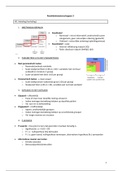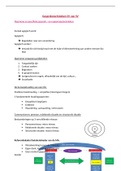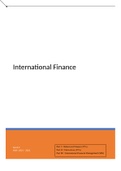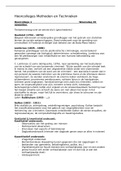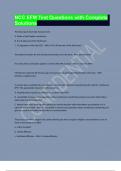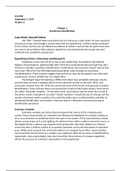1. HF1: What is strategy
Strategy = the determination of long-run goals an objectives of an enterprise and the adoption of
courses of action and the allocation of resources necessary for carrying out these goals.
Successful strategy
1) Clear and consistent long-term goals
Long term performance of companies, maximize value creation
Sales growth, capital turnover, sales margin
Example: McDonalds focus on growing sales with same capacity
2) Good understanding of the competitive environment
Good understanding of all the important determinants of industry profitability
Positive as well as negative determinants
Use of framework to determine industry structure and profitability
o PESTEL (political, economical, social, technological, environmental and legal)
o Porter 5 forces (industry rivalry, threat of entry, substitutes, supplier power and buyer
power)
3) Building and using the resources and capabilities to achieve the
goals, to develop a competitive advantage
A company has a competitive advantage If it creates more
value than its competitors, i.e a larger difference between the
consumers’ willingness to pay and the average cost
Competitive advantage : cost versus differentiation advantage
Relies on resources and capabilities which are
- Unique - Durable - Not replicable
- Relevant - Not transferable
Reputation, brands, technology, expertise,..
4) Effective implementation
The ultimate success of a firm depends on how the strategy is implemented, i.e. how the
form is organized
Intended strategy > emergent strategy > realized strategy
“strategy is what you have in mind until you get the first blow”
Organization has 3 key pillars : Structure, Systems and Culture
5) Strategic fit between goals, environment, resources and capabilities and implementation
The strategy is consistent with
o Internal environment -> resources and capabilities
o External environment
1
,How to describe a strategy?
Strategy as positioning Strategy as direction
- Where are we competing - What do we want to become and achieve
- How are we competing - How will we get there
Competing for the present Preparing for the future
Strategic decisions
- Key for long term success of company => where and how do we compete
- Typically hard to reverse => commitment & size of investment
- Provoke reaction from competitors
- Coordinating decisions necessary for coherence and consistency
Role of strategy in a firm
- Decision support
Bounded rationality and complex decision-making
Act as an heuristic
- Coordination and communication device
How to coordinate decisions and actions of all employees?
Identity and vision
- Target
Strategic intent
Corporate strategy vs. competitive strategy
1) Corporate strategy
Scope in terms of industries and markets
Diversification, vertical integration, divestments
How can corporate center reinforce the competitive advantage of the SBU’s?
2) Competitive or business strategy
How to compete in a particular industry or market?
How and iin what markets can the SBU gain and sustain a competitive advantage?
SBU = strategic business unit, a unit of a company or a group that is responsible for its strategy in its
markets and controls the resources and capabilities to implement such strategy
Competition takes place at the industry (SBU) level and not at the corporate level
When should a strategy be reviewed
- Results are disappointing and not attributable to slowdown of market
- Important changes take place in the market, by competitors, changes in technology
- Existing resources and capabilities are underutilized
- Top management is replaced
- Shareholders want a different strategy
- New opportunities arise and substantial investments need to be made
History of strategy
- Military strategy
- Business strategy
Corporate planning
Strategic management
Resources based view
Dynamic capabilities
2
, CASE: Madonna
1) What business/industry is Madonna in?
- Record music - Concerts - Books
- Music videos - Movies - Publishing
2) Are these business related? Are there synergies between different businesses?
Corporate strategy : economies of scope across different businesses
Use resources and capabilities across different business
Exploits artistic creations and superstar image across different businesses
Record release, videos, concert tours, movies, books,…
3) What are the key resources and capabilities in the particular industry? How does Madonna score
on these?
- Singing - Songwriting - Dancing
- Musicianship - Acting - Beauty
Superstar image
4) Why has Madonna been so successful? What are the main elements of her strategy?
Superstar image
Advantage in any business she enters, whether it is music, acting, …
Competitive strategy
o Early identification of key trends in music, style, and popular culture and incorporating
such themes into her own image and products
o Periodic renewal of her “product life cycle” – each of these renewals based around a
coherent and complementary package of music, style, fashion, and personal
demeanor. Continual renewal and reinvention since 1980!
o Outsourcing to access resources and capabilities of others in order to complement her
own restricted range of resources and capabilities.
2. HF2: Drivers of Value creation
Value created = WTP – costs
Value captured = value created – value
captured by consumers // price – costs
EBITDA = Earnings before interest, Taxes,
Depreciation and Amortization
EBIT = Earnings before interest and taxes
NOPAT = Net Operating Profit After Taxes
NOPLAT = Net Operating Profit Less Adjusted
Taxes
NOPLAT
ROIC=
K
K = invested capital = E (Equity) + D (Debt)
ROIC = Return on invested capital
EVA = Economic Value Added = key measure for evaluating performance of a company
>0 if ROIC > WACC
WACC = Weighted Average Cost of Capital
- t = corporate tax rate
3
Strategy = the determination of long-run goals an objectives of an enterprise and the adoption of
courses of action and the allocation of resources necessary for carrying out these goals.
Successful strategy
1) Clear and consistent long-term goals
Long term performance of companies, maximize value creation
Sales growth, capital turnover, sales margin
Example: McDonalds focus on growing sales with same capacity
2) Good understanding of the competitive environment
Good understanding of all the important determinants of industry profitability
Positive as well as negative determinants
Use of framework to determine industry structure and profitability
o PESTEL (political, economical, social, technological, environmental and legal)
o Porter 5 forces (industry rivalry, threat of entry, substitutes, supplier power and buyer
power)
3) Building and using the resources and capabilities to achieve the
goals, to develop a competitive advantage
A company has a competitive advantage If it creates more
value than its competitors, i.e a larger difference between the
consumers’ willingness to pay and the average cost
Competitive advantage : cost versus differentiation advantage
Relies on resources and capabilities which are
- Unique - Durable - Not replicable
- Relevant - Not transferable
Reputation, brands, technology, expertise,..
4) Effective implementation
The ultimate success of a firm depends on how the strategy is implemented, i.e. how the
form is organized
Intended strategy > emergent strategy > realized strategy
“strategy is what you have in mind until you get the first blow”
Organization has 3 key pillars : Structure, Systems and Culture
5) Strategic fit between goals, environment, resources and capabilities and implementation
The strategy is consistent with
o Internal environment -> resources and capabilities
o External environment
1
,How to describe a strategy?
Strategy as positioning Strategy as direction
- Where are we competing - What do we want to become and achieve
- How are we competing - How will we get there
Competing for the present Preparing for the future
Strategic decisions
- Key for long term success of company => where and how do we compete
- Typically hard to reverse => commitment & size of investment
- Provoke reaction from competitors
- Coordinating decisions necessary for coherence and consistency
Role of strategy in a firm
- Decision support
Bounded rationality and complex decision-making
Act as an heuristic
- Coordination and communication device
How to coordinate decisions and actions of all employees?
Identity and vision
- Target
Strategic intent
Corporate strategy vs. competitive strategy
1) Corporate strategy
Scope in terms of industries and markets
Diversification, vertical integration, divestments
How can corporate center reinforce the competitive advantage of the SBU’s?
2) Competitive or business strategy
How to compete in a particular industry or market?
How and iin what markets can the SBU gain and sustain a competitive advantage?
SBU = strategic business unit, a unit of a company or a group that is responsible for its strategy in its
markets and controls the resources and capabilities to implement such strategy
Competition takes place at the industry (SBU) level and not at the corporate level
When should a strategy be reviewed
- Results are disappointing and not attributable to slowdown of market
- Important changes take place in the market, by competitors, changes in technology
- Existing resources and capabilities are underutilized
- Top management is replaced
- Shareholders want a different strategy
- New opportunities arise and substantial investments need to be made
History of strategy
- Military strategy
- Business strategy
Corporate planning
Strategic management
Resources based view
Dynamic capabilities
2
, CASE: Madonna
1) What business/industry is Madonna in?
- Record music - Concerts - Books
- Music videos - Movies - Publishing
2) Are these business related? Are there synergies between different businesses?
Corporate strategy : economies of scope across different businesses
Use resources and capabilities across different business
Exploits artistic creations and superstar image across different businesses
Record release, videos, concert tours, movies, books,…
3) What are the key resources and capabilities in the particular industry? How does Madonna score
on these?
- Singing - Songwriting - Dancing
- Musicianship - Acting - Beauty
Superstar image
4) Why has Madonna been so successful? What are the main elements of her strategy?
Superstar image
Advantage in any business she enters, whether it is music, acting, …
Competitive strategy
o Early identification of key trends in music, style, and popular culture and incorporating
such themes into her own image and products
o Periodic renewal of her “product life cycle” – each of these renewals based around a
coherent and complementary package of music, style, fashion, and personal
demeanor. Continual renewal and reinvention since 1980!
o Outsourcing to access resources and capabilities of others in order to complement her
own restricted range of resources and capabilities.
2. HF2: Drivers of Value creation
Value created = WTP – costs
Value captured = value created – value
captured by consumers // price – costs
EBITDA = Earnings before interest, Taxes,
Depreciation and Amortization
EBIT = Earnings before interest and taxes
NOPAT = Net Operating Profit After Taxes
NOPLAT = Net Operating Profit Less Adjusted
Taxes
NOPLAT
ROIC=
K
K = invested capital = E (Equity) + D (Debt)
ROIC = Return on invested capital
EVA = Economic Value Added = key measure for evaluating performance of a company
>0 if ROIC > WACC
WACC = Weighted Average Cost of Capital
- t = corporate tax rate
3

